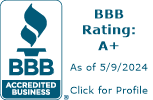Knowing When to File an Insurance Claim for Roof Damage
In the Twin Cities, severe weather, including hailstorms, can wreak havoc on your roof. As a homeowner, understanding when to file an insurance claim for roof damage is crucial to protecting your investment and ensuring your roof's longevity. Filing a claim at the right time can save you from costly repairs and potential out-of-pocket expenses. In this article, we'll explore key indicators that it's time to file an insurance claim, steps to take before doing so, and how to work with your insurance company and a trusted roofing contractor.
Signs It’s Time to File an Insurance Claim
1. Visible Hail Damage
Hailstorms are notorious for causing roof damage in the Twin Cities. If you notice visible damage such as dents, dings, or missing shingles, it’s a strong indicator that your roof has been compromised. Hail damage often results in granule loss on asphalt shingles, leading to bald spots that leave your roof vulnerable to further damage. If you suspect hail damage, it's crucial to contact a roofing company for an inspection to determine the extent of the damage.
2. Leaks and Water Stains
Water infiltration is one of the most serious consequences of roof damage. If you observe leaks or water stains on your ceilings or walls, it’s a sign that your roof’s integrity has been compromised. In such cases, immediate action is required to prevent further water damage. Filing an insurance claim can help cover the costs of roof repair and prevent long-term issues such as mold growth or structural damage.
3. Widespread Damage After a Storm
Following a severe storm, it’s essential to assess the condition of your roof. If your neighborhood has been hit by a hailstorm or strong winds, there’s a good chance your roof has sustained damage as well. Even if the damage isn't immediately visible, it’s wise to have a professional inspection. A residential roofing replacement may be necessary if the damage is extensive, and filing an insurance claim can help offset the costs.
Steps to Take Before Filing a Claim
1. Document the Damage
Before filing an insurance claim, it’s important to document all visible damage. Take clear photos and videos of the affected areas, including any interior damage such as leaks or water stains. This documentation will be valuable when working with your insurance company and can expedite the claims process.
2. Schedule a Professional Inspection
Contact a reputable roofing company in MN to conduct a thorough inspection of your roof. A professional roofer can assess the extent of the damage and provide a detailed report. This report will be essential when filing your claim, as it offers evidence to support the need for repairs or replacement.
3. Review Your Insurance Policy
Before filing a claim, review your homeowner’s insurance policy to understand what is covered. Policies vary, and some may have specific exclusions or limitations on roof damage coverage. Knowing what your policy covers can help you set realistic expectations and avoid surprises during the claims process.
4. Get an Estimate
Obtain an estimate from your roofing contractor for the cost of repairs or replacement. This estimate will help you determine whether it’s worth filing a claim, especially if the damage is minor and the repair costs are close to your deductible.
Working with Your Insurance Company
1. File the Claim Promptly
Once you’ve documented the damage and gathered all necessary information, file your insurance claim promptly. Delaying could result in further damage and may affect your coverage. Insurance companies often have time limits for filing claims, so it’s important to act quickly.
2. Meet with the Adjuster
After you file your claim, your insurance company will send an adjuster to assess the damage. Be sure to provide them with the documentation and the inspection report from your roofing company. It’s also a good idea to have your roofing contractor present during the adjuster’s visit to ensure all damage is accounted for.
3. Negotiate if Necessary
In some cases, the insurance company’s initial offer may not cover the full cost of repairs or replacement. If this happens, don’t hesitate to negotiate. Provide additional documentation or seek a second opinion from another roofing contractor to strengthen your case.
When Not to File a Claim
While filing an insurance claim can be beneficial, there are situations where it may not be the best option:
- Minor Damage: If the cost of repairs is close to or below your deductible, it may be more cost-effective to pay for the repairs out of pocket.
- Previous Claims: If you’ve filed multiple claims in a short period, it could result in higher premiums or even policy cancellation. Consider whether the damage is significant enough to warrant another claim.
Conclusion: Protect Your Home and Your Investment
Knowing when to file an insurance claim for roof damage can save you time, money, and stress. By promptly addressing hail damage in the Twin Cities and working with a trusted roofing company, you can ensure your roof is repaired or replaced efficiently and effectively. Regular inspections, especially after severe weather, can help you catch damage early and prevent costly repairs in the future.
For additional resources, consider visiting the Insurance Information Institute (III) for guidance on filing claims and understanding your policy. Additionally, maintaining a relationship with a reliable roofing contractor can provide peace of mind and expert support when you need it most.

